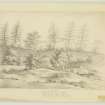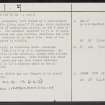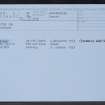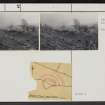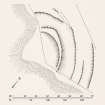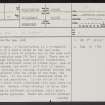Pricing Change
New pricing for orders of material from this site will come into place shortly. Charges for supply of digital images, digitisation on demand, prints and licensing will be altered.
Castle Qua
Castle (Medieval), Earthwork (Bronze Age)
Site Name Castle Qua
Classification Castle (Medieval), Earthwork (Bronze Age)
Canmore ID 46570
Site Number NS84SE 1
NGR NS 8739 4491
Datum OSGB36 - NGR
Permalink http://canmore.org.uk/site/46570
- Council South Lanarkshire
- Parish Lanark
- Former Region Strathclyde
- Former District Clydesdale
- Former County Lanarkshire
NS84SE 1 8739 4491.
(NS 8739 4491) Castle Qua (NR)
OS 6" map (1941)
The Castle of the Quaw, or Castle-dykes, is a stronghold bounded by traces of a double ditch on the land side, enclosing about half a rood of ground, and on the side next the river by a precipice some 200 feet high. There are no traces of buildings excepting some possible foundations, but there are some artificial caves or arched ways. One of them, which was opened, was about 7 or 8 feet in length, and 4 feet wide, running in a bending direction towards the centre of the inclosure from the brink of the rock ; the height about 3 1/2 feet. It was built of undressed stone in corbelled fashion and unmortared. In the bottom of the archway was a fat black earth intermixed with some bones in the state of ashes. Several other archways or holes like the above, running in different directions, still exist, although not hitherto explored. There are similar archways at Cairny Castle (NS84SE 5).
Statistical Account (OSA) 1795
Castle Qua is a promontory formed by a semicircular rampart and double ditch, about 8ft deep, which encircles a spur at the top of precipitous cliffs, on the N side of the Mouse Water. Its internal diameter is 25 to 30 paces from E to W. Inside are some hollows, doubtless the site of the 'vaults' referred to in the OSA. Some of the stone of the rampart is visible.
OS 6" map annotated by O G S Crawford, 9 September 1938.
This fort, generally as described above, measures internally 28m from E to W by 30m transversely. No stones were visible in the interior, though some hollows about 0.5m deep were apparent. Both ditches are about 0.8m wide; the outer one has been almost entirely ploughed out and is 0.8m maximum depth on the N.
Surveyed at 1:2500.
Visited by OS (JLD) 15 February 1962
The earthworks at Castle Qua are thought to be almost certainly medieval.
RCAHMS 1978
Note (19 August 2014 - 10 August 2016)
This small promontory work, situated high up on a bluff overlooking the Mouse Water, includes features that almost certainly indicate that it is the remains of a medieval castle. Triangular on plan, the interior measures 30m from N to S by a maximum of 28m transversely (0.04ha) immediately to the rear of the substantial rampart, which has been drawn in an arc across the neck of the promontory to defend the northern and eastern approaches. The rampart is fronted by a broad ditch, and on the E there are the remains of a second, though this is lost at the edge of the arable field to the N and cannot be traced any further round to the W. On the N, the plan drawn up by RCAHMS investigators in 1973 depicts a track obliquely crossing the outer lip of the inner ditch, but this is a misunderstanding of the subtlety of the earthworks, in which the line of the outer lip of the ditch to either side appears to extend behind a break of slope lower down the counterscarp; rather than a mutilation by later trackway, these are probably the decayed remains of the abutment of a bridge spanning the ditch, possibly to an entrance over the top of the rampart. Such a feature would be unique in Iron Age fortifications, and though it does not rule out the possibility of an earlier occupation, it suggests that this is a medieval castle akin to a ringwork.
Information from An Atlas of Hillforts of Great Britain and Ireland – 10 August 2016. Atlas of Hillforts SC1568
Excavation (5 July 2017 - 25 August 2017)
NS 8318 4350 and NS 8739 4491 (NS84SW 2 and NS84SE 1) An excavation was undertaken, 5 July – 25 August 2017, at two hilltop enclosures close to Lanark - Castle Qua and Black Hill. The work formed part of CAVLP’s Investigating the Past project, which focused on the archaeology and landscape of the first millennia in the Clyde and Avon Valleys. The excavations involved members of local community groups, volunteers, service users from Phoenix Futures and volunteers from Clydesdale Community Initiatives as well as students and staff from the University of Glasgow’s Department of Archaeology.
At Castle Qua, one trench outside the large earthwork that defines the site revealed a substantial outer ditch, while a second trench inside the enclosure found the substantial stone foundations of a structure. Very few artefacts were discovered during the excavations and it is hoped that post-excavation analysis will identify suitable dating evidence.
Five trenches were excavated across key features on Black Hill, revealing detailed evidence for ramparts and earthworks. A trench was also excavated on top of the cairn that provides the NTS viewing point, confirming the supposition that it is a large and very substantial Bronze Age monument. A number of artefacts were recovered from Black Hill, including prehistoric pottery from beneath the rampart, which should allow for dating of this enigmatic hilltop site.
Archive: NRHE
Funder: Heritage Lottery Fund, LEADER and Historic Environment Scotland
Paul Murtagh – Northlight Heritage
(Source: DES, Volume 18)












